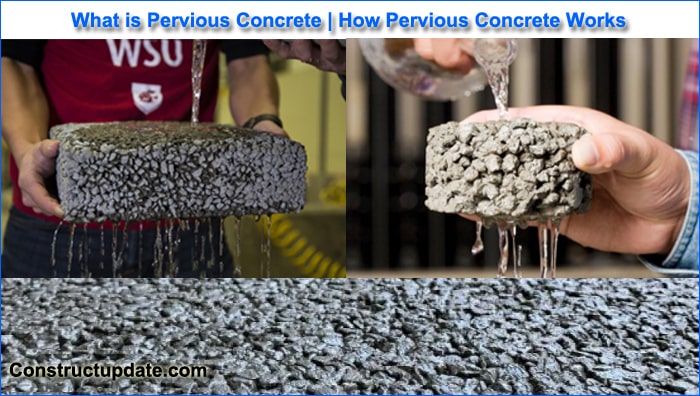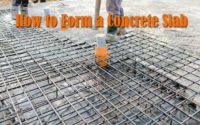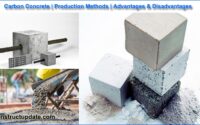What is Pervious Concrete | How Pervious Concrete Works | Pervious Concrete Advantages
What is Pervious Concrete?
The primary ingredients of pervious concrete, often known as a material with almost no slump and open grading, are portland cement, coarse aggregate, little to no fine aggregate, admixtures, and water.
Together, these elements will result in a material that is strengthened and contains connected pores that are easily permeable to water. Pervious concrete is frequently regarded as a sustainable building material because of its capacity to reduce stormwater runoff, improve stormwater quality, possibly recharge groundwater resources, and diminish the effects of the urban heat island effect.
How is Pervious Concrete made?
In order to create a paste that forms a thick shell around the aggregate particles, pervious concrete is made by carefully regulating the proportions of cementitious ingredients and water. Contrary to typical concrete, the mixture has a considerable void content of between 15 and 25 percent since it includes little to no sand.
When enough paste is used to coat and bind the aggregate particles together, a network of swiftly draining, extremely porous gaps is formed. In comparison to ordinary concrete, strength is decreased by both the low mortar content and the high porosity, although sufficient strength can still be easily attained for many applications.

Each square foot of pervious concrete allows 3 to 8 gallons of water to pass through each minute. Pervious concrete can be helpful in replenishing groundwater and lowering stormwater runoff by enabling precipitation to sink into the earth. This ability can lessen the requirement for stormwater management systems such as swales and retention ponds. Hardscape surfaces and stormwater management are integrated through pervious pavement.
How Pervious Concrete Works
Pervious concrete is essentially a structural concrete pavement with a significant volume of interconnected voids (15 to 35 percent). It is formed from a combination of cement, coarse particles, and water, just like traditional concrete. However, it has little to no sand, resulting in a porous open-cell structure that allows water to easily travel through.
When pervious concrete is used for paving, it may quickly absorb stormwater at a rate of 3 to 5 gallons per minute per square foot of surface area, which is greater than the flow rate required to stop runoff in the majority of rain events. Rainwater may be retained in a layer of coarse gravel beneath the pavement or allowed to seep into the subsurface soil.
As a retention area, the pavement itself serves to reduce the amount of contaminated runoff that generally happens with impermeable pavements. The filtration procedure aids in the water’s purification. Aerobic bacteria in the voids of the pavement’s open cells assist in the breakdown of dangerous pollutants and chemicals when the water percolates through it.
Sustainability Benefits of Pervious Concrete
There are many environmental advantages to pervious concrete. For further information, refer to the technical briefs and related sustainability solutions.
Water Management in Storms: Pervious paving lowers stormwater flow and pollutant loads by enabling water to soak through and infiltrate. can help with LEED Credit 6.
Lessen Site Disturbance: By combining paving and drainage, stormwater management may need less site space, allowing for a smaller development footprint. might count toward a LEED v4 credit Management of Rainwater on Sustainable Sites.
Local materials are often mined and produced locally. can count toward LEED Credit M 5.
Recycled material Cement can be partially replaced with fly ash, slag cement, or silica fume, and recycled aggregates can take the place of freshly mined gravel.
Recycled materials can help achieve LEED Credit M 4.
General Guidelines for Specifications
The characteristics of pervious concrete vary depending on design, materials utilised, and compaction techniques. Below are some general principles for specs.
Permeability: Water typically flows through pervious concrete at a rate of 3 to 8 gallons per square foot per minute, however, this pace can be increased to double it if needed.
Compressive Power: A wide variety of applications can benefit from the compressive strengths that pervious concretes can achieve, which range from 500 to 4000 pounds per square inch (psi).
Flexural Power: Pervious concrete has a flexural strength range of 150 to 550 psi.
Shrinkage: Although pervious concrete dries more quickly than traditional concrete, it nevertheless shrinks far less during the drying process. Numerous pervious concretes are constructed without control joints and are let to develop random cracks.
Resistance to Freeze-Thaw: The saturation level of the voids in the concrete at the moment of freezing determines the resistance to freeze-thaw. According to observations made in the field, pervious concrete’s quick drainage properties prevent saturation. Pervious concrete should be installed on a base of drainable rock that is 6 to 18 inches thick where significant moisture and freeze-thaw conditions are expected, such as 1-inch crushed stone.
Resistance to abrasion: Abrasion and raveling of aggregate particles can be an issue with pervious concrete due to its rougher surface texture and open structure, especially in areas where snowploughs are employed to clear sidewalks. Rocks that are loosely attached to the surface might pop out under traffic loads, causing surface raveling in fresh pervious concrete.





